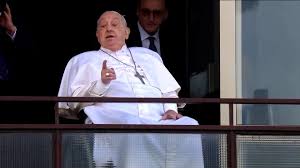Pope Francis Returns to The Vatican
Sheamus Finnegan
Staff Writer
March 23 marked the end of Pope Francis’ thirty-eight-day hospital stay and his first public appearance since entering the Agosto Gemelli Polyclinic Hospital on February 14. During his stay at Gemelli, the Pope was treated for serious issues with his respiratory tract, issues which were near-fatal on several occasions.
The Pope’s health crisis started on February 14, when the Holy See Press Office announced Francis’ admission to the Gemelli Hospital in Rome after days of persistent bronchitis. Three days later, after extensive testing, it was determined that the Pope suffered from a “polymicrobial infection of the respiratory tract.”

On February 18, the Holy See Press Office announced that the Pope was also suffering from double pneumonia and was being administered antibiotics and corticosteroid – a type of prescription medication used to reduce inflation.
Just 10 days later, the Pope experienced what would be the worst part of his hospital stay: a breathing crisis (an isolated bronchospasm) during which he inhaled his own vomit. Doctors quickly responded with bronchial aspiration to clean his airways and employing mechanical ventilation.
Doctor Sergio Alfieri told an Italian news outlet that the Holy Father’s condition on the 28th was so dire that medical staff had to deliberate over whether they should “stop and let him go or force it and try with all the drugs and therapies possible, running the very high risk of damaging other organs.”
A few days later, the Pope “suffered two episodes of acute respiratory insufficiency caused by an accumulation of endobronchial mucus and consequent bronchospasm. Two bronchoscopies were performed.
Fortunately, after 38 days at Gemelli Hospital, and with the support and prayers from around the world, the Holy Father was released from Gemelli Hospital and returned to the Vatican on Sunday, March 23.
The Pope made his first public appearance since being hospitalized when he greeted a crowd of nearly three thousand from the balcony of the Hospital.
The Significance of Pope Francis’ health crisis is twofold.
First, it demonstrated the Pope’s leadership and commitment to serving the Church. Even in the midst of his health crisis, he made many efforts to continue his ministry from his Hospital bed.
The Holy Father made multiple calls to parishioners of the Holy Family Church in Gaza to offer words of support, encouragement, and prayer. Additionally, on March 16, while still recovering, he united his prayers with other people who are sick around the world.
Second, it united millions around the globe in prayer. Catholics, whether supportive or critical of Francis, made countless prayers – both public and private – for the health of the Holy Father.
Contact Sheamus at sheamus.finnegan@student.shu.edu

